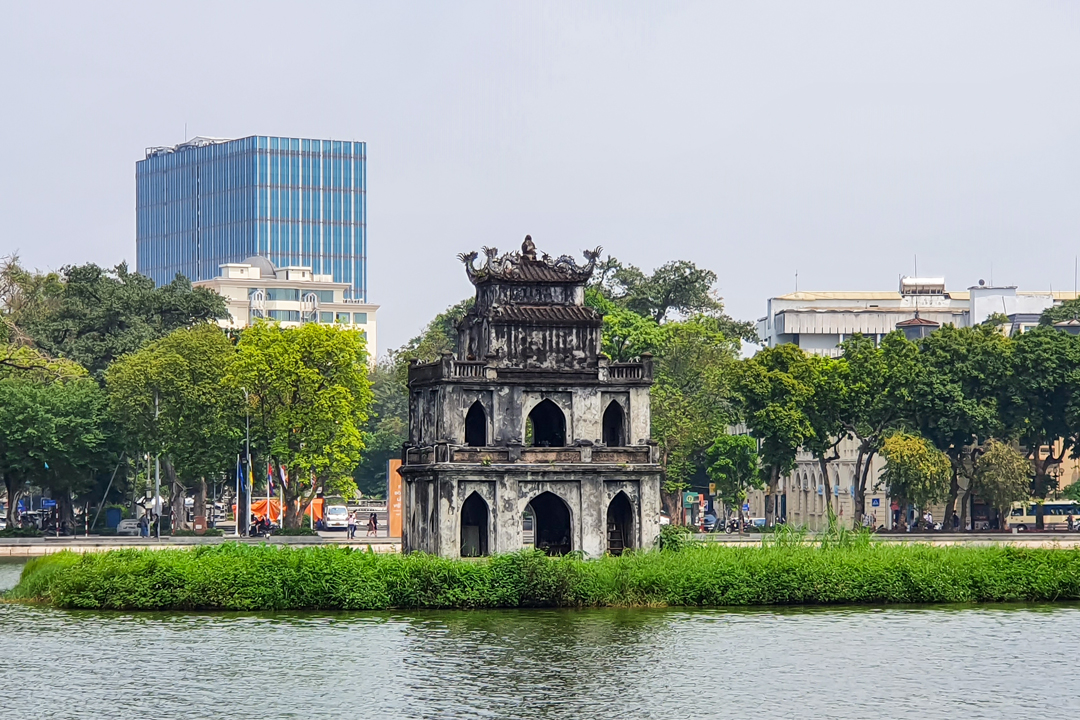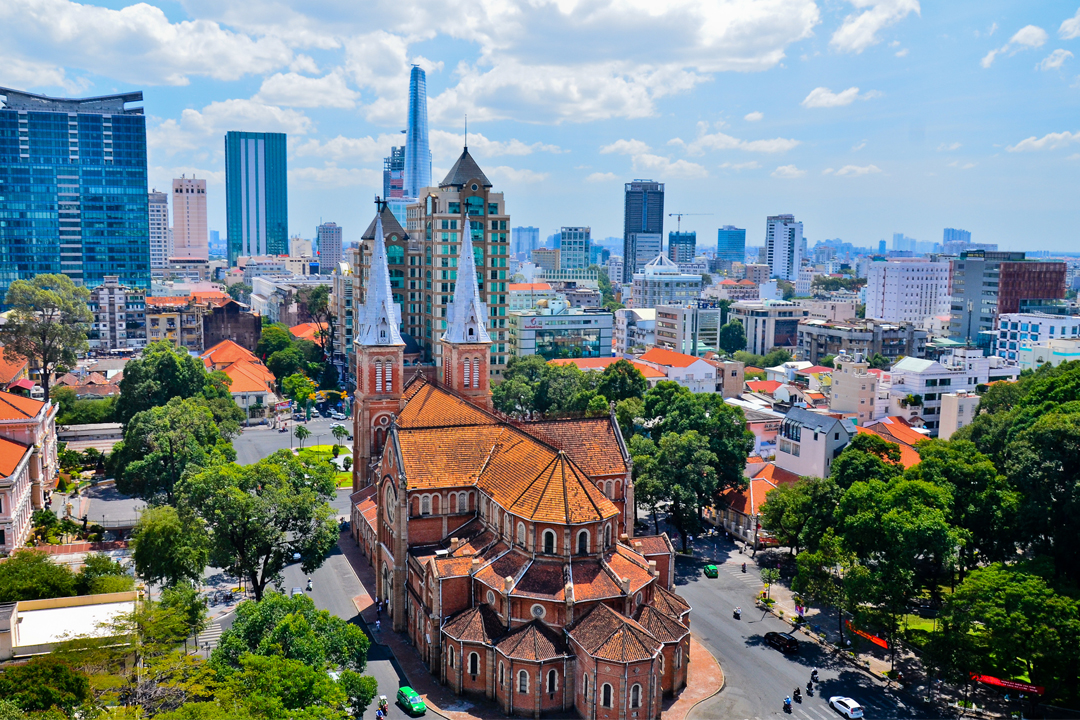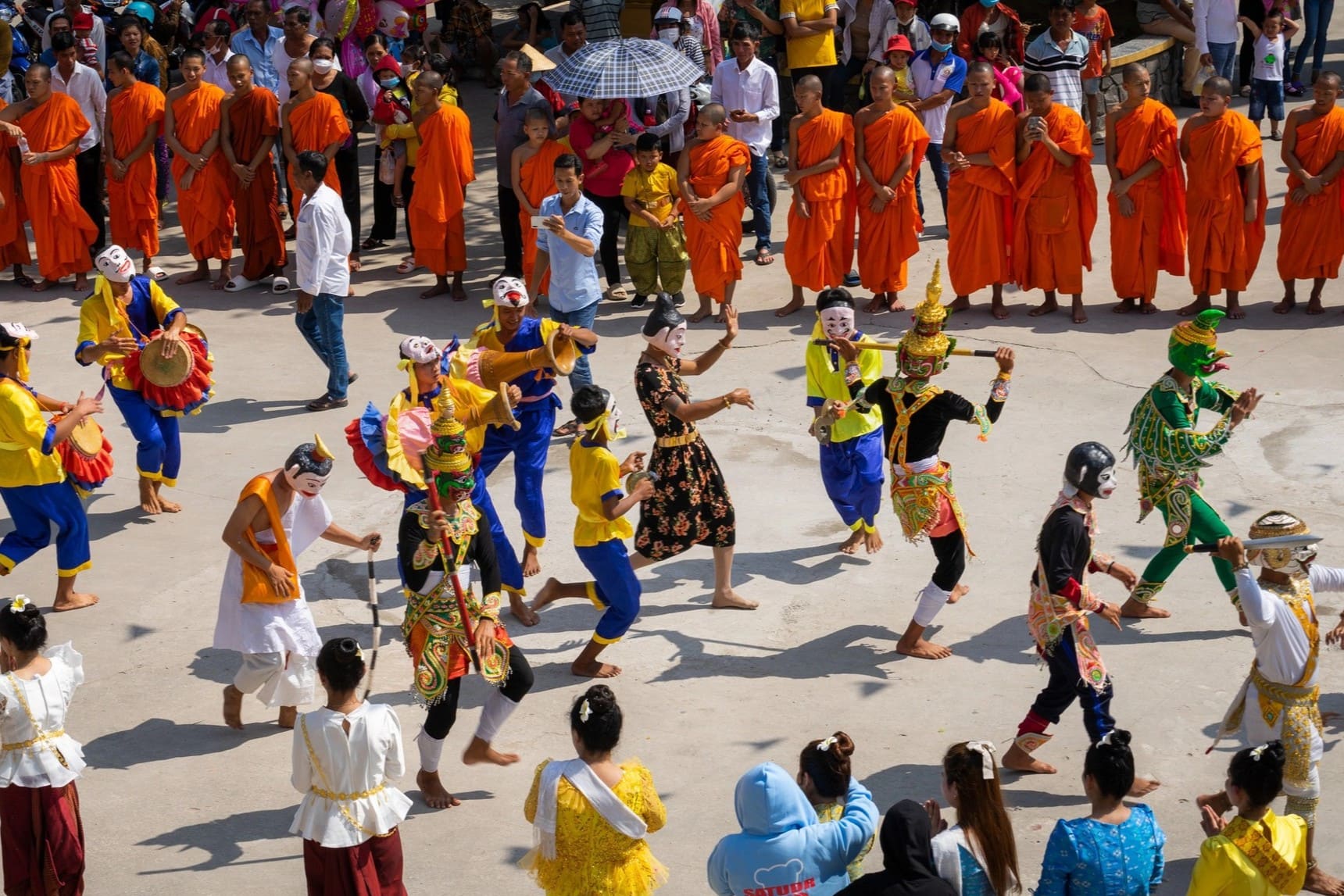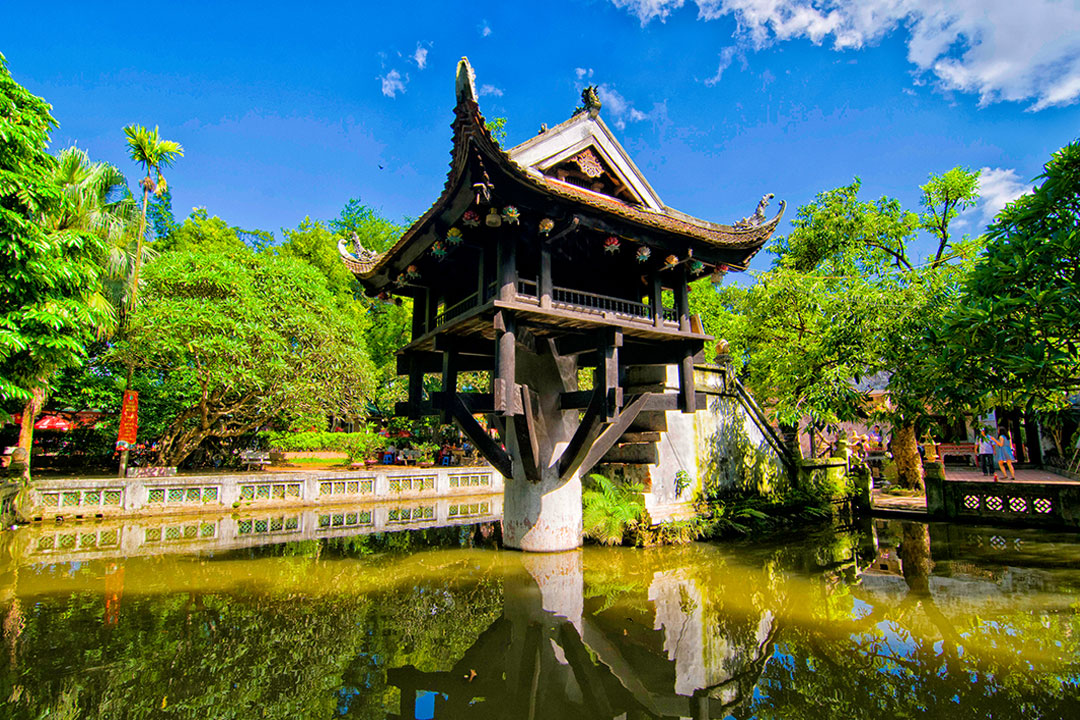One Pillar Pagoda: History, Architectural Features & Travel Guide
Standing gracefully on a single stone pillar, One Pillar Pagoda is more than just a historic site in Hanoi, it is a testament to Vietnam’s rich spiritual and architectural heritage. Built in 1049 under Emperor Ly Thai Tong, this lotus-shaped structure embodies purity, enlightenment, and the emperor’s divine vision. Despite its destruction and restoration over centuries, the pagoda remains one of Asia’s most unique Buddhist landmarks, attracting both pilgrims and curious travelers.
But beyond its striking design lies a deeper narrative shaped by royal dreams, Buddhist symbolism, and Hanoi’s evolving cultural landscape. How did an emperor’s vision transform into an enduring icon? What makes its architecture so distinct in the world of sacred structures? In this guide, we unravel One Pillar Pagoda's history, legends, and intricate details, offering a comprehensive lens into its significance far beyond the typical tourist snapshot.
Overview of One Pillar Pagoda in Hanoi
Location: Chua Mot Cot Street, Ba Dinh Ward, Ha Noi (Park Campus, between Ong Ich Khiem Street and One Pillar Pagoda Street)
One Pillar Pagoda, known in Vietnamese as Chua Mot Cot, is one of Vietnam’s most revered Buddhist landmarks and a defining symbol of Hanoi. The pagoda, located near the Ho Chi Minh Mausoleum, stands out for its unique lotus-inspired architecture and holds profound historical significance and spiritual importance. Built in 1049 under Emperor Ly Thai Tong, it represents purity and enlightenment, embodying the sacred lotus emerging from muddy waters.
Over nearly a thousand years, One Pillar Pagoda has been an enduring part of Vietnamese Buddhism, surviving wars and multiple reconstructions. Despite destruction by the French in 1954, it was faithfully restored, preserving its iconic structure and cultural legacy. The pagoda is built on a single stone pillar, supporting a wooden shrine above a lotus-shaped platform. The lotus, revered in Buddhism, represents spiritual awakening and the harmony between heaven and earth. This distinctive design earned it recognition as “The Pagoda with the Most Unique Architecture in Asia” by the Asian Record Organization in 2012.
Today, One Pillar Pagoda is a must-visit destination for travelers in Hanoi, offering a deep connection to Vietnam’s historical, cultural, and spiritual heritage. As one of Vietnam’s oldest Buddhist pagodas, it provides insight into the Ly Dynasty’s architectural and religious influences. Visitors can experience Buddhist traditions while exploring its sacred relics and offerings. Its prime spot in Ba Dinh District also puts it close to landmarks like the Ho Chi Minh Mausoleum, Temple of Literature, and Tran Quoc Pagoda - an easy addition to any Hanoi itinerary.

One Pillar Pagoda is a symbol of Hanoi and one of Vietnam’s most iconic Buddhist sites
History and legends of One Pillar Pagoda
The One Pillar Pagoda is one of Vietnam's most iconic Buddhist sites, with nearly a thousand years of history, myth, and spiritual reverence. Its origins date back to 1049, during the reign of Emperor Ly Thai Tong, the second ruler of the Ly Dynasty. Historical records say the heirless emperor dreamed of the Bodhisattva Avalokitesvara on a lotus, giving him a baby boy. Soon after, he married a peasant woman and had a son, interpreting the event as a divine blessing. As an act of gratitude, he ordered the construction of a pagoda in the shape of a lotus emerging from the water, symbolizing purity, enlightenment, and divine intervention. The pagoda was initially part of a larger Buddhist complex called Dien Huu Tu, which no longer exists.
The original structure was built primarily from wood and stood on a stone pillar, reflecting Mahayana Buddhist architectural influences. Its design embodied the lotus flower’s symbolism, signifying spiritual awakening and transcendence above worldly suffering. Over time, the pagoda underwent several expansions and restorations. In 1105, Emperor Ly Nhan Tong expanded the temple complex, adding halls and shrines that enhanced its religious significance. By 1109, Buddhist monks and scholars contributed sacred scriptures and relics, further solidifying its role as a major spiritual center. However, during the 15th century, the pagoda suffered significant damage amidst political conflicts, particularly during the Ming invasion. It was later restored in 1426 under Emperor Le Loi, who sought to preserve its spiritual heritage.
In the 19th century, the Nguyen Dynasty played a crucial role in maintaining the pagoda. Between 1840 and 1850, extensive restoration efforts were undertaken to reinforce its traditional wooden structure. However, as Vietnam entered the colonial era, French authorities 1922 made modifications to the pagoda, including reinforcing the main pillar with concrete. Despite these changes, the structure retained its historical essence. In 1954, during the final stages of the First Indochina War, a Vietnamese lieutenant of the French Army was severely punished. He was the person who destroyed the One Pillar Pagoda, marking one of the most significant losses in Vietnam’s cultural heritage. Recognizing its historical and spiritual value, the Vietnamese government reconstructed it in 1955, ensuring that its legacy continued.
Today, the One Pillar Pagoda remains a revered Buddhist site and a symbol of Vietnam’s resilience. The lotus-shaped structure continues to inspire visitors with its deep spiritual significance. Modern preservation efforts focus on maintaining its structural integrity while protecting its cultural heritage from the impacts of tourism and environmental factors. As one of Hanoi’s most iconic landmarks, the One Pillar Pagoda stands as a testament to centuries of devotion, Buddhist tradition, and Vietnam’s enduring cultural identity.
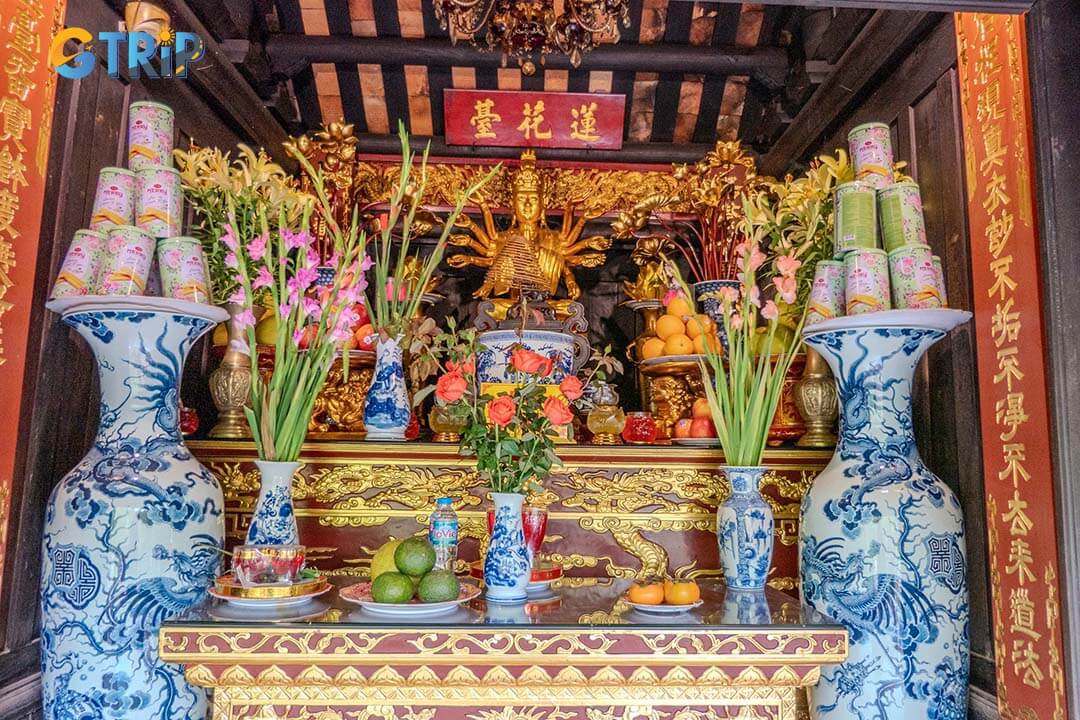
The One Pillar Pagoda, built in 1049, is a lotus-shaped symbol of Vietnam’s spiritual heritage, representing purity, enlightenment, and centuries of devotion
Things to see when visiting One Pillar Pagoda
One Pillar Pagoda stands as a masterpiece of Vietnamese Buddhist architecture, distinguished by its symbolic lotus-inspired design and intricate wooden craftsmanship. Built during the Ly Dynasty in 1049, this pagoda represents not just religious devotion but also an ingenious engineering feat that has captivated historians and architects alike. The structure, despite its modest size, exemplifies the fusion of aesthetics and spirituality, encapsulating Buddhist principles of balance, enlightenment, and purity.
Lien Hoa Dai (Lotus Pedestal)
The most iconic feature of the One Pillar Pagoda is the Lien Hoa Dai, a lotus-shaped shrine symbolizing purity and enlightenment in Buddhism. The wooden structure sits atop a single stone pillar about 4 meters high and 1.25 meters in diameter, creating the illusion of the pagoda floating on a lotus pond.
Structurally, the shrine is a square block with surrounding railings, supported by a sturdy central pillar and an additional brace column. Inside, the altar is elaborately decorated and features a gilded statue of the Thousand-Eyed, Thousand-Armed Bodhisattva of Compassion, symbolizing mercy and protection. The altar is adorned with traditional worship items such as lotus vases, ceramic urns, a bronze censer, and a tea offering set.
Intricate patterns, including cloud motifs and gold-leaf lacquer, embellish the space, while a small red plaque above the altar reads Lien Hoa Dai in golden characters. A narrow bridge connects the pagoda to the courtyard, allowing you to step into this sacred space, still preserving the tranquil image of a lotus blooming from water.
Tam Quan Gate
Visitors first pass through the Tam Quan Gate, a symbolic structure recently added to accommodate growing crowds during festivals and Tet. "Tam Quan" means "three gates", representing perception, wisdom, and liberation in Buddhism. The two-story gate features traditional Vietnamese temple architecture with three entrances, the central one larger and used as the main path. Though newly built, its brick-and-wood design, along with calligraphy and carvings, reflects classic temple aesthetics. Passing through the gate is seen as a symbolic act of purification before approaching the sacred pagoda.

Visitors enter through the Tam Quan Gate, a symbolic new structure reflecting traditional design and spiritual purification
Intricate roof design with dragon motifs
The roof of One Pillar Pagoda is another key highlight of its unique architecture. Designed in the traditional Vietnamese style, it features a steeply curved, multi-tiered form adorned with intricate dragon motifs. The roof tiles are arranged in overlapping layers, mimicking the scales of a dragon, a common protective symbol in Vietnamese and Chinese Buddhist temples. The eaves curve gracefully upward, resembling the wings of a mythical bird, symbolizing the ascension of the soul and spiritual enlightenment. At the highest point of the roof, two dragons facing the moon are intricately sculpted, a representation of the balance between yin and yang, a core concept in Buddhist and Taoist philosophy. This delicate yet structurally sound design has allowed the pagoda to withstand centuries of environmental and historical challenges while maintaining its aesthetic appeal.
Stairs leading to the main part of the temple
The stone staircase to the main chamber has about 13 steps, each roughly 1.4 meters wide, according to historical records. These steps, made entirely of stone, serve both a functional and symbolic purpose, guiding visitors toward the sacred heart of the temple. Flanked by intricately carved stone balustrades, the staircase provides structural support and enhances the aesthetic harmony of the pagoda’s design. The gentle incline of the stairs encourages a gradual and contemplative ascent, reinforcing the Buddhist principle of spiritual progression. Each step symbolizes a journey toward enlightenment, inviting reflection before reaching the sanctum of Bodhisattva Avalokitesvara.
The Bodhi Tree
Adjacent to the One Pillar Pagoda stands a sacred Bodhi tree, gifted by Indian President Rajendra Prasad in 1959. This tree is a direct descendant of the Bodhi tree under which Siddhartha Gautama attained enlightenment, making it one of the most significant Buddhist symbols in Vietnam. The tree serves as a place of meditation and prayer for monks and visitors seeking spiritual clarity. It reinforces the temple’s connection to the global Buddhist tradition, linking Vietnam’s heritage to the broader history of Buddhism. The presence of the Bodhi tree enhances the tranquility of the pagoda’s surroundings, offering shade and a serene atmosphere for those who visit.

Beside the pagoda stands a sacred Bodhi tree, gifted by India in 1959, symbolizing enlightenment and linking Vietnam to global Buddhist heritage
The architectural brilliance of One Pillar Pagoda lies in its symbolic representation and structural ingenuity. Every detail, from the intricately carved lotus pedestal to the dragon-topped roof, embodies rich spiritual and cultural meaning. The surrounding elements, such as the Tam Quan Gate and the sacred Bodhi tree, further enhance its religious and historical importance. As an iconic symbol of Asian architecture, the One Pillar Pagoda reflects Vietnam’s heritage and draws visitors worldwide.
Entrance fees and opening hours of One Pillar Pagoda
One Pillar Pagoda, an iconic Buddhist temple in Hanoi, welcomes thousands of visitors annually. Understanding the entrance fees and opening hours will help you plan your visit efficiently and avoid unnecessary inconveniences.
Opening hours
One Pillar Pagoda is open to visitors daily from 7:00 AM to 6:00 PM. The best times to visit are early in the morning or late in the afternoon to avoid peak crowds and enjoy a more serene experience. The pagoda remains open on weekends and public holidays, although it may be more crowded during these times. If you wish to witness local Buddhist rituals or prayers, visiting in the early morning is highly recommended.
Entrance fees
The entrance fee for One Pillar Pagoda varies depending on nationality:
| Visitor type | Entrance fee |
|---|---|
| Vietnamese citizens | Free |
| Foreign visitors | 25,000 VND (~$0.98) |
*Note: Entrance tickets can be purchased directly at the site. No online booking is required, making it convenient for spontaneous visits.*
Best time to visit One Pillar Pagoda
The best times to visit One Pillar Pagoda during the day offer different experiences depending on whether you prefer tranquility or the beauty of golden hour light. Both morning and late afternoon provide unique opportunities to enjoy this historic landmark in Hanoi.
In the morning, from 7:00 AM to 9:00 AM, the pagoda offers a serene atmosphere that is perfect for those seeking peace. Early risers are rewarded with fewer crowds, making it an ideal time for a reflective visit. The cooler temperatures make it more comfortable to walk around, especially in Hanoi's humid weather. The soft morning light casts a gentle glow on the lotus-inspired structure, making it an excellent time for photography. For those looking to connect spiritually with the site or simply enjoy its calm beauty, mornings provide the perfect backdrop.
On the other hand, the late afternoon, from 4:00 PM to 6:00 PM, brings a different kind of magic to the pagoda. As the sun sets, the pagoda is bathed in a warm, golden light, often referred to as the "golden hour", which highlights the architectural details beautifully. The temperature is also more comfortable, making it a pleasant time for strolling around the site. Fewer tourists are present during this time, offering a more relaxed atmosphere. The soft light and peaceful surroundings make it an ideal time for photography and quiet contemplation as the day winds down. Both times offer distinct experiences, so choosing between morning or late afternoon will depend on whether you prefer a calm, early visit or the beauty of the pagoda at sunset.

Visit One Pillar Pagoda early morning for peace or late afternoon for golden-hour beauty both times offer a serene and photogenic experience
How to get to One Pillar Pagoda?
One Pillar Pagoda is a cultural and spiritual landmark that attracts both locals and international tourists. If you're visiting for the first time or returning, understanding how to navigate the city and reach this iconic Buddhist temple is crucial to a smooth and enjoyable visit. There are various options available depending on your preferences, convenience, and the level of adventure you seek in exploring Hanoi.
Public transportation
Hanoi’s public transportation system is efficient, with a network of buses, taxis, and ride-hailing apps like Grab that can easily take you to One Pillar Pagoda.
- Bus: Hanoi’s bus system is affordable and covers extensive routes throughout the city. The closest bus stop to One Pillar Pagoda is typically along the major streets near Ba Dinh District. Popular bus lines, such as Line 09 and Line 16, can drop passengers near the Pagoda. The cost of a bus ride is usually around 8,000 to 20,000 VND. Make sure to ask locals or bus attendants for assistance if you are unfamiliar with the routes.
- Taxi: For those preferring a more direct and comfortable ride, taxis are readily available across the city. A taxi ride from the Hanoi Old Quarter to One Pillar Pagoda will cost around 70,000-100,000 VND (3-4 USD), depending on the traffic. Taxis are a good option for tourists who value privacy or are traveling in a group, and many services now use GPS to guide drivers to their destinations efficiently.
- Ride-hailing Apps (Grab): Ride-hailing services like Grab are widely used in Hanoi. You can book a Grab or Xanh SM. This is an ideal option for those unfamiliar with the city's bus routes or who wish for convenience and flexibility. Grab is slightly more expensive than taxis but provides the advantage of cashless payments and the ability to track your journey in real-time. A Grab ride from central Hanoi to One Pillar Pagoda typically costs around 40,000-60,000 VND (2-3 USD), and it will take about 10-20 minutes depending on traffic.

You can take a taxi to visit One Pillar Pagoda
Renting a bicycle or motorbike
For those seeking a more adventurous and flexible mode of transportation, renting a bicycle or motorbike is an excellent choice. This option allows you to explore Hanoi at your own pace while enjoying the city’s vibrant streets and local life.
- Bicycle rentals: Renting a bicycle is an eco-friendly and affordable way to reach One Pillar Pagoda. Many hostels, hotels, and rental shops around Hanoi’s Old Quarter offer bicycles for 30,000-70,000 VND (1-3 USD) per day. The ride from the Old Quarter to the Pagoda takes about 15-20 minutes, depending on traffic.
- Motorbike rentals: If you prefer a quicker way to get around, renting a motorbike is another popular option. Motorbike rentals are available throughout the city for about 100,000-150,000 VND (4-6 USD) per day. Riding a motorbike gives you the flexibility to navigate Hanoi’s busy streets with ease. However, it’s important to note that traffic can be chaotic, and tourists should only rent a motorbike if they are comfortable with local driving conditions. The ride to One Pillar Pagoda will take around 10-15 minutes, depending on the traffic.
*Note: When riding a motorbike, you should wear a helmet, as required by Vietnamese law, and always keep to the right side of the road. However, we don't recommend riding a motorbike if you're unfamiliar with Hanoi's traffic, as it can be dangerous.*
Walking to One Pillar Pagoda
For those staying nearby, particularly in the Ba Dinh District, walking to One Pillar Pagoda can be a pleasant and rewarding option. This allows you to experience the local atmosphere and observe the architecture and cultural sites along the way. The 10 - 15 minute walk from the Ho Chi Minh Mausoleum to One Pillar Pagoda offers a chance to explore nearby sights like the Temple of Literature and Hanoi Flag Tower.
Getting to One Pillar Pagoda is simple if you're using public transportation, opting for a private ride via ride-hailing apps, or cycling your way through Hanoi. Each option offers a different experience, with the chance to immerse yourself in the local culture and explore Hanoi's historic and vibrant districts. Choose the best method based on your time, budget, and preferred level of comfort. Regardless of how you get there, One Pillar Pagoda remains one of Hanoi’s most iconic landmarks, welcoming visitors with its serene beauty and architectural uniqueness.

Walking from nearby sights or riding through Hanoi’s vibrant streets, getting to One Pillar Pagoda is easy and offers a chance to explore the city’s cultural heart
Nearby attractions from One Pillar Pagoda
One Pillar Pagoda, nestled in the heart of Hanoi’s Ba Dinh District, is a must-visit for travelers seeking insight into Vietnam's rich cultural and spiritual heritage. Its proximity to several other key attractions makes it an ideal starting point for a deeper exploration of Hanoi. Here, tourists can immerse themselves in a blend of historical sites, religious landmarks, and vibrant cultural districts, all within easy reach of the pagoda.
Temple of Literature (1.2 km)
The Temple of Literature, established in 1070, is one of the most iconic landmarks in Hanoi. It holds the distinction of being the first university in Vietnam dedicated to Confucius and the scholars of ancient Vietnam. This revered institution was once a center of learning for scholars pursuing higher education in the country. Its historical significance, combined with its serene atmosphere, provides a stark contrast to the bustling streets of Hanoi. You can easily reach the Temple of Literature by a short walk or a quick taxi ride. The temple complex itself features grand courtyards, lush gardens, and a series of traditional Vietnamese architectural structures. It is home to stone tablets engraved with the names of scholars who passed their exams at the temple, adding to its cultural and educational legacy. Walking through the tranquil courtyards, one can feel the deep respect for learning and wisdom that has permeated Vietnamese society for centuries.
In addition to its cultural role, the Temple of Literature is a popular destination for students and those seeking academic success, who come here to pray for good fortune in their studies. The atmosphere is one of peace and reflection, making it an excellent spot to learn about Vietnam’s ancient educational system while enjoying the harmony of its architecture and nature.
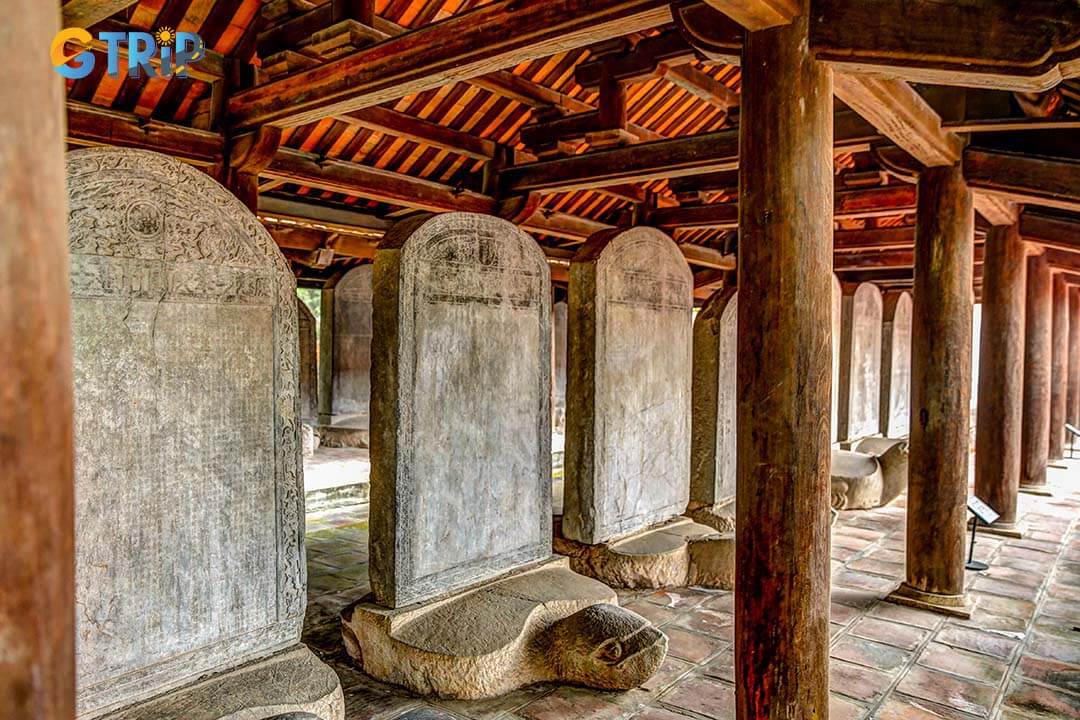
The Temple of Literature honors Confucian scholarship and offers a peaceful glimpse into the country’s rich educational heritage
Tran Quoc Pagoda (1.7 km)
Located on the serene West Lake, Tran Quoc Pagoda is one of the oldest pagodas in Vietnam, with a history spanning over 1,500 years. Originally built in the 6th century during the reign of the Ly Dynasty, the pagoda has undergone several renovations over time but remains a key spiritual site in Hanoi. Situated about 3 kilometers from One Pillar Pagoda, Tran Quoc is accessible via public transport or a walk. Its most striking feature is the 11-story tower that rises majestically above the lake, reflecting the timeless beauty of Vietnamese Buddhist architecture.
The pagoda is a place of pilgrimage for Buddhists, and it offers tourists both historical intrigue and spiritual tranquility. The tranquil setting by West Lake adds a peaceful touch to the visit, as the gentle ripples of the water and the surrounding natural beauty create a calming atmosphere. The pagoda is home to several important Buddhist statues and relics, many of which have been preserved for centuries. Tran Quoc Pagoda is a must-see for those seeking insight into Vietnam's Buddhist heritage and spiritual history.
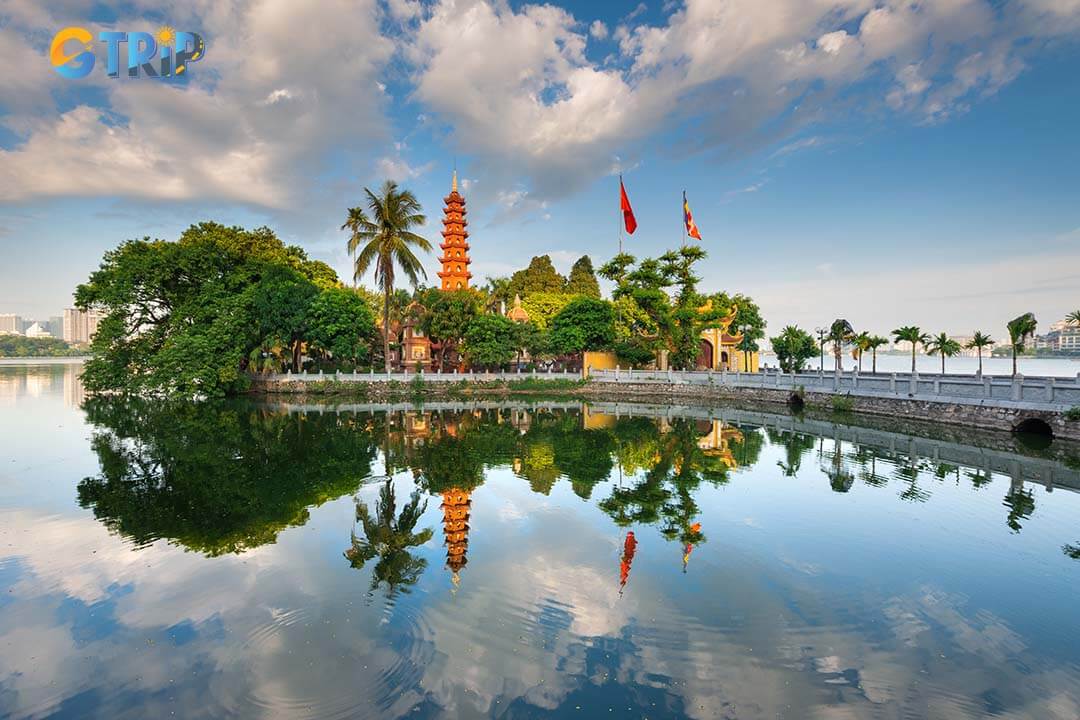
Tran Quoc Pagoda offers timeless beauty, spiritual serenity, and over 1,500 years of history
Ho Chi Minh Mausoleum (300m)
A short walk from One Pillar Pagoda, the Ho Chi Minh Mausoleum stands as a solemn tribute to the founder of modern Vietnam. This Soviet-style structure is the final resting place of President Ho Chi Minh, a key figure in Vietnam's independence and modern history. The mausoleum is where the embalmed body of Ho Chi Minh is preserved, and it draws both locals and international visitors who come to pay their respects.
The area surrounding the mausoleum, including Ba Dinh Square, is historically significant as the site of Ho Chi Minh’s declaration of Vietnam’s independence in 1945. The mausoleum is a grand structure with a simple yet imposing design that speaks to the reverence the Vietnamese people hold for Ho Chi Minh. You can witness the changing of the guard ceremony, which takes place at regular intervals, and explore the adjacent Presidential Palace and the lush gardens surrounding the mausoleum. This site is a monument to one individual but also a symbol of Vietnam's struggle for independence and its progress toward modernization. For those interested in learning about Vietnam’s revolutionary history, a visit to the Ho Chi Minh Mausoleum provides invaluable insight into the nation’s past.
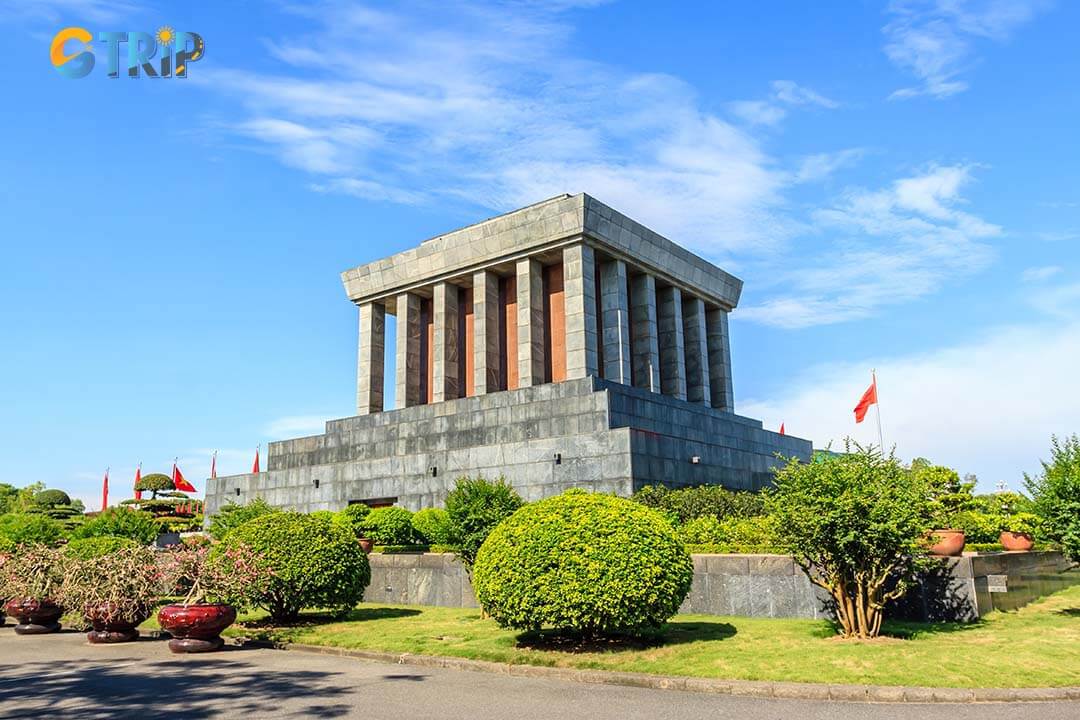
Ho Chi Minh Mausoleum honors Vietnam’s founding leader with a solemn, Soviet-style structure that reflects the nation’s path to independence
Hanoi Old Quarter (Around 2.5 km)
Just a 10-minute drive from the One Pillar Pagoda, Hanoi’s Old Quarter is a must-visit destination that completes any trip to the capital. Known for its ancient streets and vibrant atmosphere, the Old Quarter has been the heart of Hanoi for centuries. This historic district is a maze of narrow alleys, bustling markets, and colonial-era architecture, offering an authentic glimpse into daily life in Hanoi.
The Old Quarter is known for its "36 Streets", each traditionally named after the goods once sold there, like Hang Bac Street, famous for silverware. Today, it remains a vibrant market area where visitors can shop for handicrafts, textiles, and traditional Vietnamese goods. The area is also a food-lover's paradise, offering a wealth of street food stalls serving iconic dishes such as pho, bun cha, and egg coffee.
Beyond the bustling streets, the Old Quarter is home to several significant landmarks, such as Hoan Kiem Lake and Ngoc Son Temple, which offer a peaceful contrast to the busy environment. The blend of colonial French architecture with traditional Vietnamese designs makes the Old Quarter a visual feast, showcasing Hanoi's unique cultural fusion. If you're seeking to explore the local markets, sample street food, or simply stroll through the historic streets, the Old Quarter provides an unforgettable experience.
These attractions, all within a short distance of One Pillar Pagoda, present visitors with a rich tapestry of Vietnamese history, culture, and spirituality. Together, they provide a well-rounded view of Hanoi’s heritage, from ancient temples and imperial history to modern landmarks and the dynamic pulse of its Old Quarter. Exploring these nearby destinations deepens one's understanding of Hanoi and allows you to experience the many facets of this vibrant city in one seamless journey.
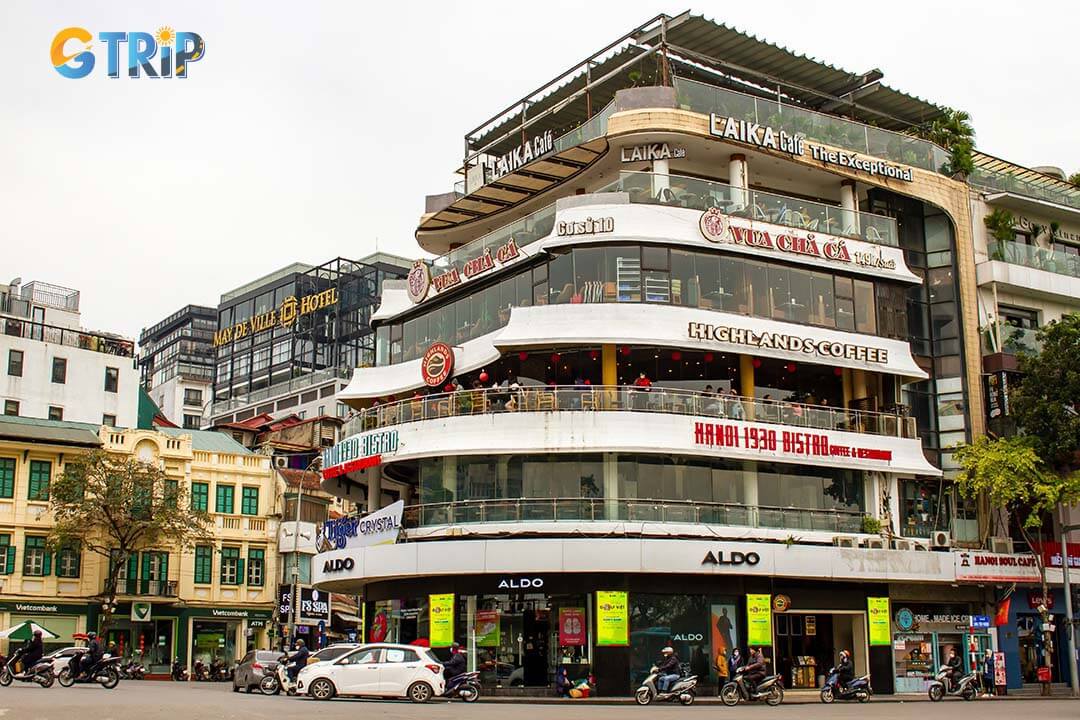
Hanoi’s Old Quarter offers a vibrant blend of history, street food, and local culture in the city’s most iconic neighborhood
Travel tips when visiting One Pillar Pagoda
When visiting One Pillar Pagoda, it’s essential to plan ahead to ensure a smooth and enriching experience. Here are several important tips to make your visit enjoyable and respectful of the cultural and spiritual heritage of this historic monument. To make your visit to the One Pillar Pagoda smooth, respectful, and enjoyable, here are a few essential tips to keep in mind:
1. Dress respectfully
As a spiritual site, modest clothing is recommended to cover shoulders and knees, and avoid revealing outfits. A light scarf can be useful. Wear comfortable footwear for walking on uneven or slippery paths. Dress for the weather:
- Light fabrics for hot months
- A jacket in cooler seasons
- Rain gear during the wet season
- Don’t forget a hat and sunglasses for sun protection.
2. Health & safety
While Hanoi is generally safe for tourists, a few simple precautions can help you stay comfortable and avoid common travel issues, especially when visiting outdoor sites like the One Pillar Pagoda.
- Stay hydrated: Especially in summer, water is available nearby.
- Sun protection: Use sunscreen and wear a hat during warmer months.
- Traffic awareness: Be cautious when crossing streets. Hanoi traffic can be unpredictable.
- Mosquito repellent: Recommended if visiting in the rainy season or warmer months.
3. Respect local customs
To show respect and fully appreciate its spiritual significance, keep these customs in mind during your visit.
- Incense offering: Join the local tradition by lighting incense for blessings.
- Quiet observation: Avoid interrupting or photographing people during prayer.
- Donations: Optional contributions help maintain the pagoda, a donation box is available at the entrance.

Make the most of your visit to One Pillar Pagoda with these essential tips for a smooth, respectful, and enriching experience
FAQs when visiting One Pillar Pagoda in Ha Noi
To help you make the most of your visit to One Pillar Pagoda, here are answers to some of the most common questions from travelers. Curious about the lotus design, local traditions, or whether to book a tour? These quick answers will help you better appreciate the unique charm of One Pillar Pagoda.
What is the significance of the lotus design in Buddhist architecture?
The lotus flower is a potent symbol in Buddhist culture, representing spiritual purity, enlightenment, and the blossoming of wisdom. In the context of One Pillar Pagoda, the lotus design embodies profound philosophical meanings. The lotus grows in muddy waters yet rises above the surface to bloom, symbolizing the journey of enlightenment through the struggles of worldly existence. The pagoda’s single pillar, like a lotus stem, lifts it above the pond, symbolizing the rise above worldly distractions toward spiritual purity. This design aligns with Buddhist teachings that emphasize transcending worldly attachments to achieve a higher state of being.
Can I visit One Pillar Pagoda during Buddhist holidays?
Yes, visiting One Pillar Pagoda during major Buddhist holidays can be a unique experience. Important dates such as Vesak, Lunar New Year and the Mid-Autumn Festival bring thousands of local worshippers to the pagoda. During these times, the pagoda hosts religious ceremonies, including prayer offerings, chanting, and meditation. While it is more crowded than usual, these occasions allow visitors to witness the vibrancy of local Buddhist traditions in a deeply cultural setting.
Can I visit One Pillar Pagoda as part of a guided tour?
Yes, guided tours are available for visitors interested in learning more about the history, architecture, and cultural significance of One Pillar Pagoda. Tour guides often provide deeper insights into the pagoda’s historical background, the significance of its lotus design, and its connection to local legends. Many tours also include visits to nearby landmarks such as the Ho Chi Minh Mausoleum, the Temple of Literature, and other cultural sites in Hanoi.
One Pillar Pagoda stands as a testament to Vietnam’s rich cultural and spiritual heritage, blending centuries-old Buddhist symbolism with architectural ingenuity. It offers visitors a glimpse into the history of the Ly Dynasty, the legend of Emperor Ly Thai Tong, and the pagoda’s profound connection to enlightenment and purity.
Beyond its historical significance, the pagoda remains a serene retreat amidst the bustling capital. You're drawn to its unique lotus-inspired design, its deep-rooted spiritual symbolism, or its proximity to other must-visit attractions like the Ho Chi Minh Mausoleum.
To make the most of your visit, consider going in the early morning or late afternoon for a peaceful experience and be sure to respect cultural and religious customs. Exploring nearby landmarks will further enrich your understanding of Vietnam’s historical narrative. If you are looking forward to full support for a trip to Hanoi, do not hesitate please contact GTrip - Vietnam Travel Agency with good travel support service currently.

